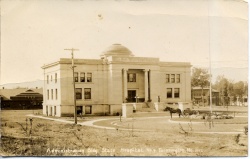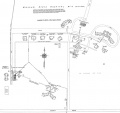Farmington State Hospital
| Farmington State Hospital | |
|---|---|
 | |
| Construction Began | 1901 |
| Opened | 1903 |
| Current Status | Active |
| Building Style | Cottage Plan |
| Location | Farmington, MO |
| Peak Patient Population | 1,879 in 1954 |
| Alternate Names |
|
History
Received it's first patients in 1903. The state budgeted $150,000 to build the hospital itself and in 1901, an additional $120,000 went for new buildings and equipment. Five cottages were built for patients and from 1901 to 1902 a dining room, kitchen, power house, barns, laundry, ice plant, the folk building (set aside for nurses, attendants and recreation), an administration building, the Hall building, the superintendents' residences and the Harrison Building, a receiving building and acute care hospital, were constructed. Dr. William Hall admitted the first three patients in 1903 and by 1904, the population stood at 332. By 1907, 795 patients were housed at the hospital. By 1922, the hospital was so crowded the superintendent's home was converted to housing for women patients. In 1925, the Hyde Building was built and the Folk Building was converted to house female patients. Another milestone was marked in 1925 when Dr. Emmett Hoctor took over as superintendent of Farmington State Hospital, then known as State hospital Number 4.
In 1931, the diathermy machine was introduced to treat paresis, a form of paralysis. Before, physicians had induced a high fever in paretic patients by injecting them with malaria germs. While the malarial fever did help some patients, the danger of dying of malaria outweighed the benefits. When penicillin was discovered, it replaced the diathermy machine, chiefly because it was dramatically effective for treating syphillis, the major cause of paresis. In 1932, the hospital established its first community-based treatment center when it set up a clinic for mental health education and consultation in the New Madrid County Courthouse. Other clinics were set up in Mississippi and Scott Counties and today clinics can be found in Sikeston, Cape Girardeau, Kennett and West Plains. On June 6, 1940, Dr. Paul Schrader performed the first lobotomy. In the first months of 1940, 64 major lobotomies were performed at the hospital. All told, 200 lobotomies were performed at the hospital, the last in 1943. Electroshock therapy was introduced in 1942. During the 1930s and '40s, several WPA projects were completed on the hospital grounds, including utility tunnels, storm sewers and a new dairy barn. The 1950s and '60s were a period of overcrowding for the hospital. In 1954, the average daily patient population was 1,879. The recommended capacity was 1,600. By 1970, the hospital was serving 25 counties and the Alcoholism Treatment Center had been expanded to handle drug abuse patients. Treatments in practice included recreation, music and occupational therapy.
In 1972, the Blair Building, the last of the new buildings, was opened as a psychiatric medical facility. By 1975, the average daily population had fallen to 521 patients at the state hospital, but an average of 600 people were treated monthly on an outpatient basis. In 1978, Dr. Hoctor retired after a 53-year career with Farmington State Hospital, and the institution marked its 75th anniversary. By 1982, the population had fallen to 320 on the hospital grounds, the level stipulated under the conversion plan and became part of the Missouri Department of Corrections.[1]
References
- ↑ Published by THE DAILY JOURNAL, Flat River, St. Francois Co. MO, Fri. April 24, 1987 in a supplement "Reflections: View of the Past - A Look To the Future" written by Peggy O'Farrell, Daily Journal News Editor


